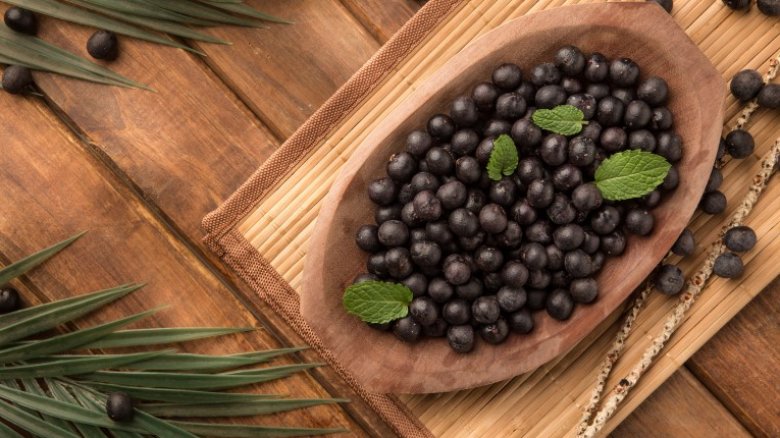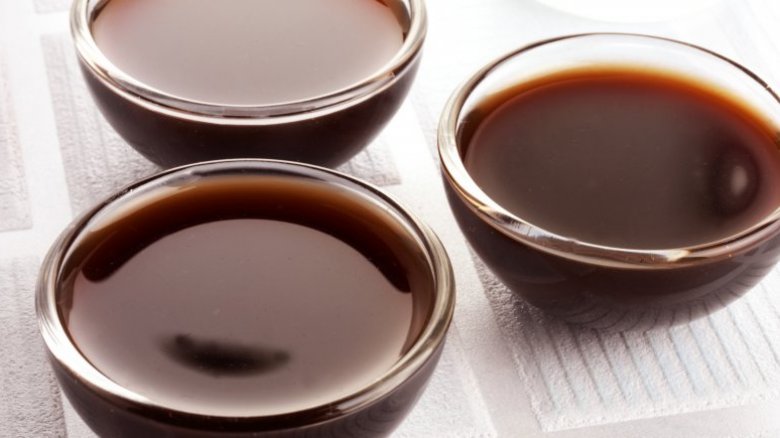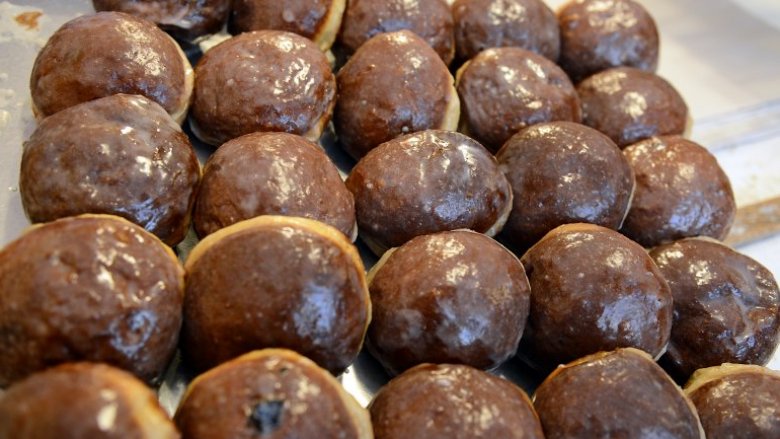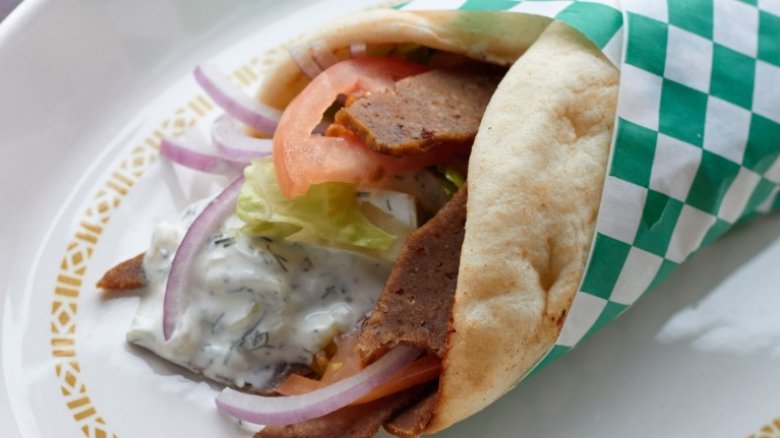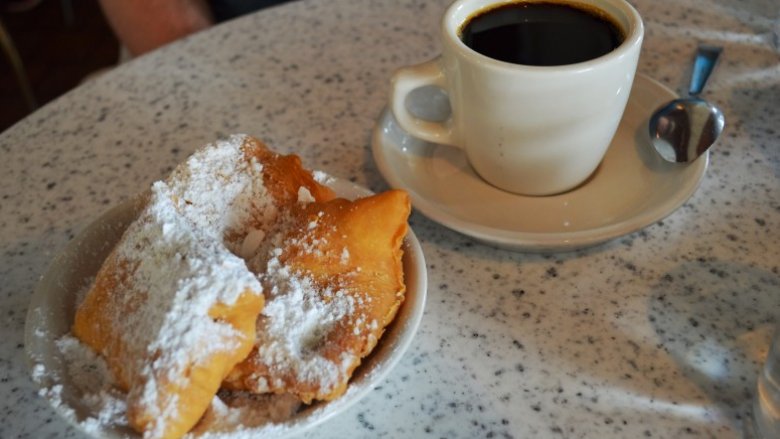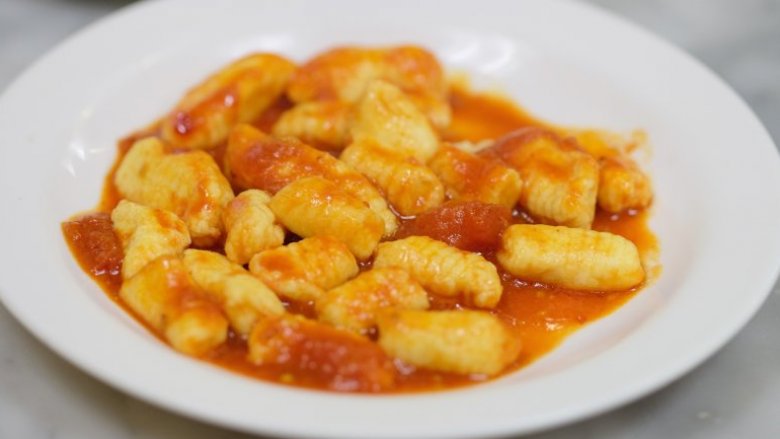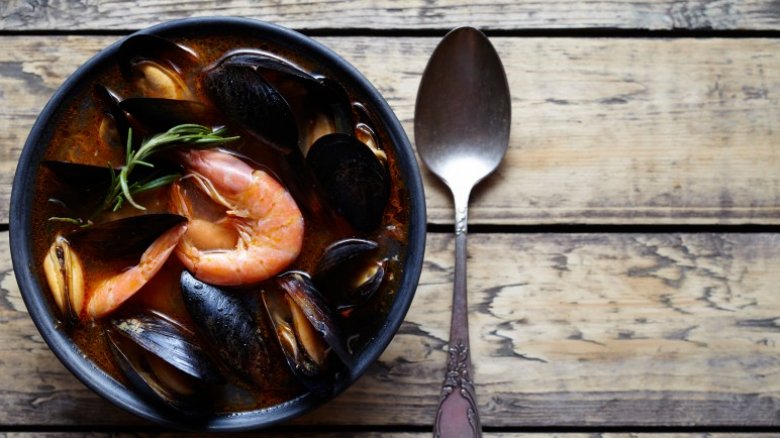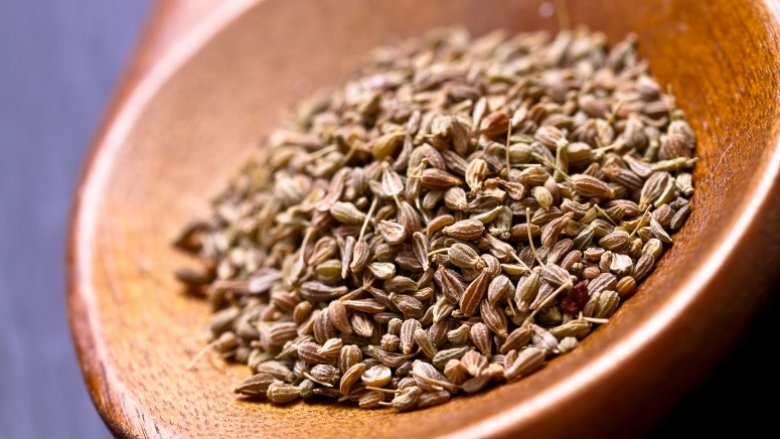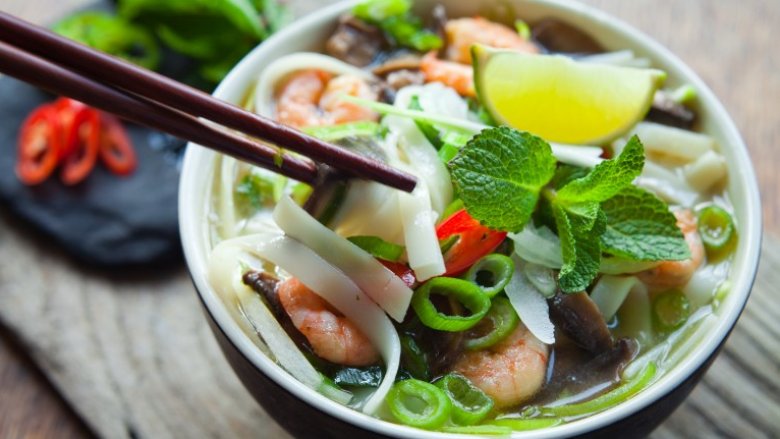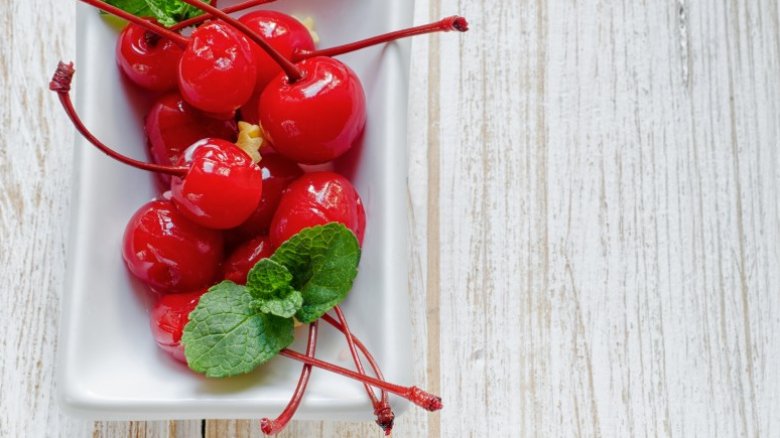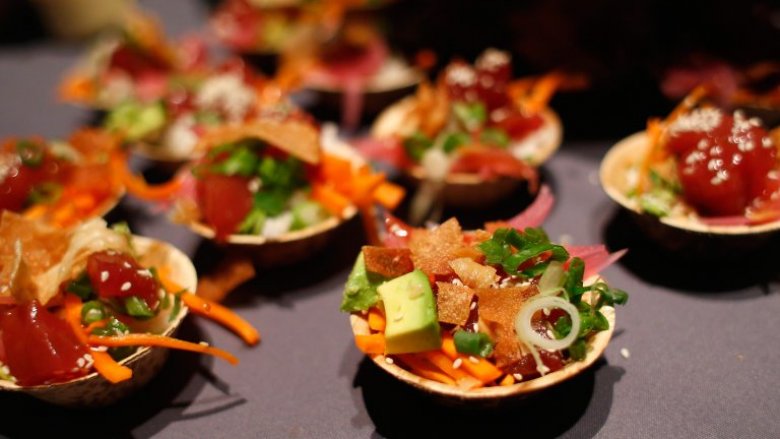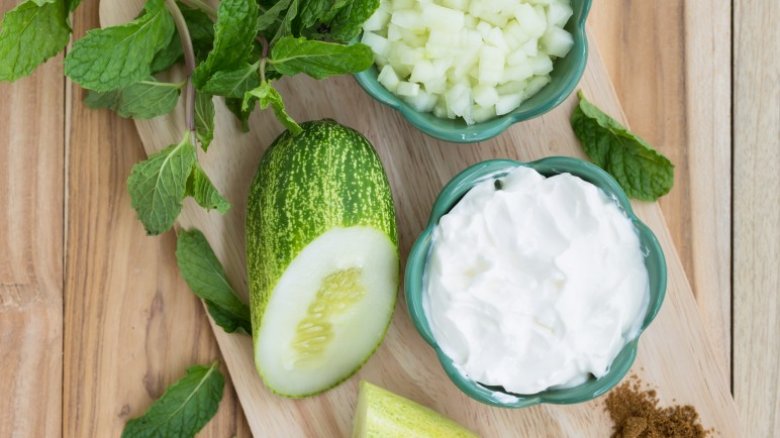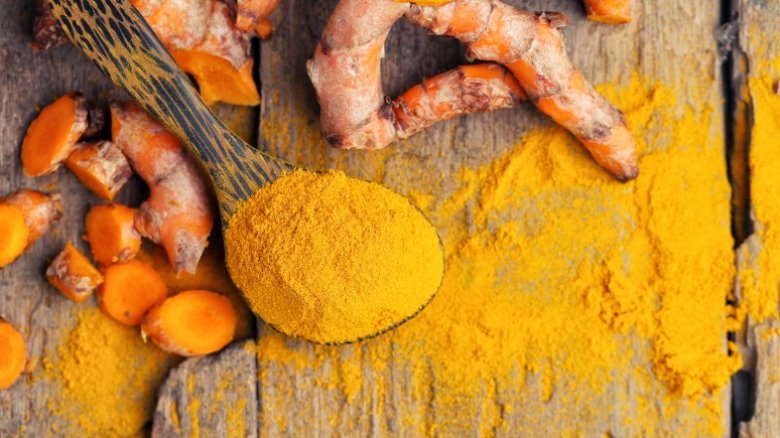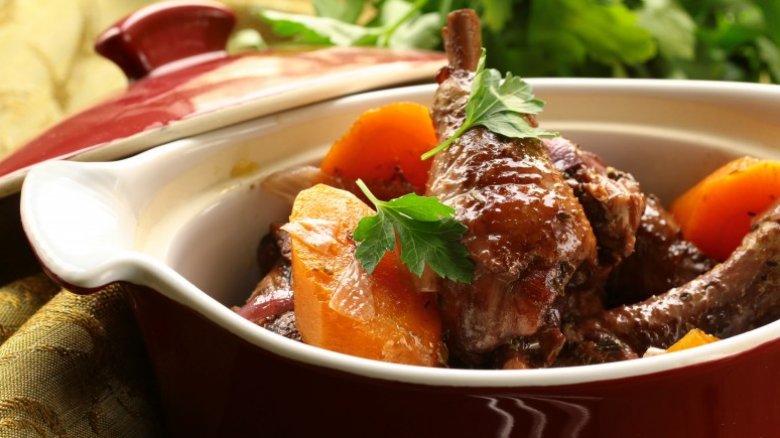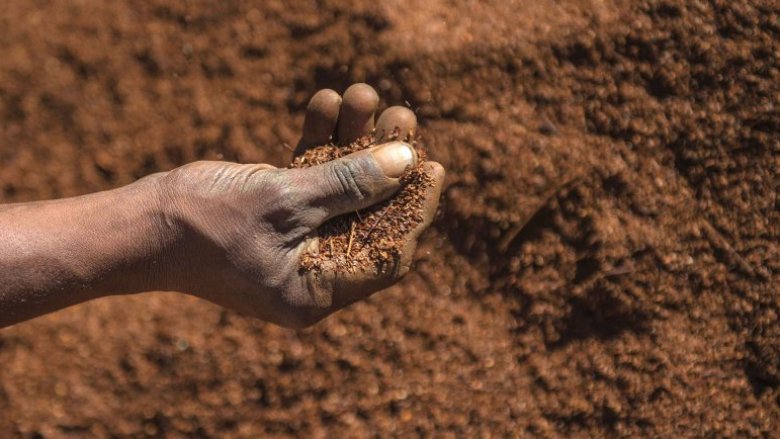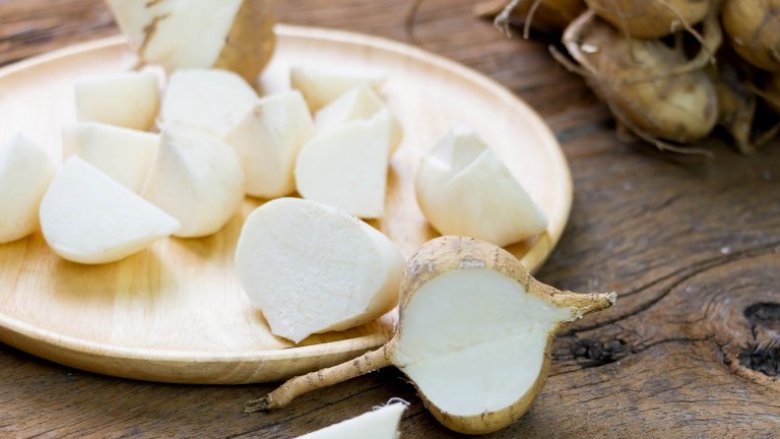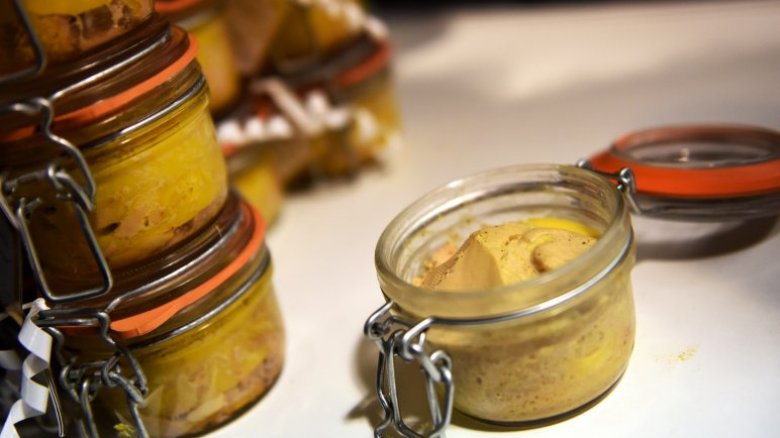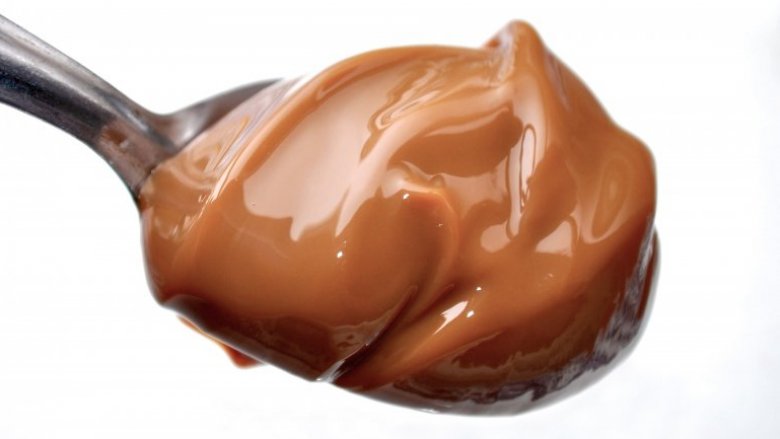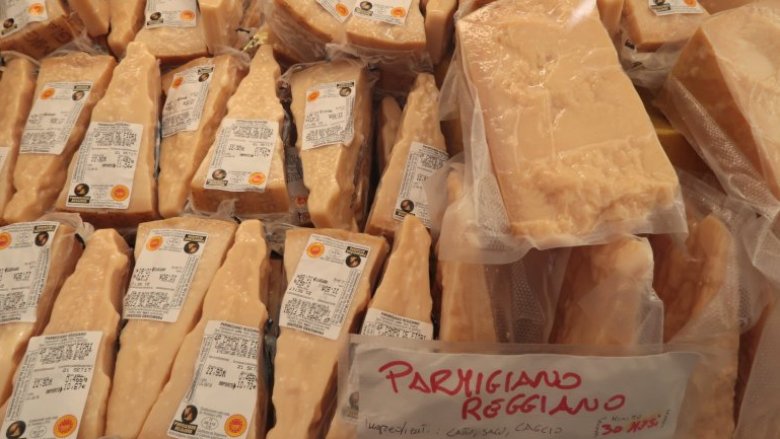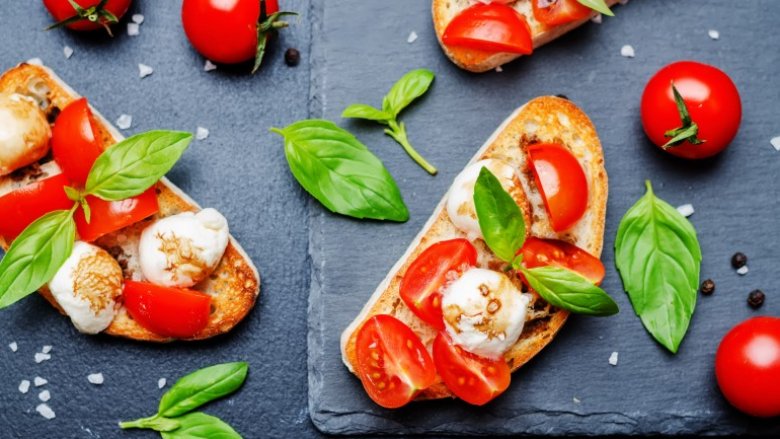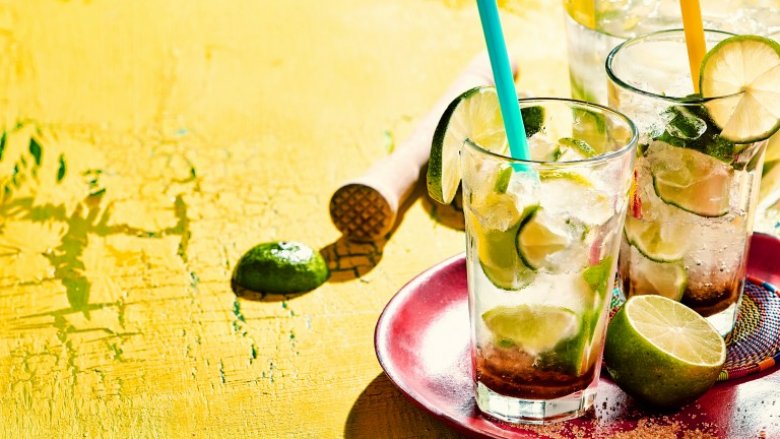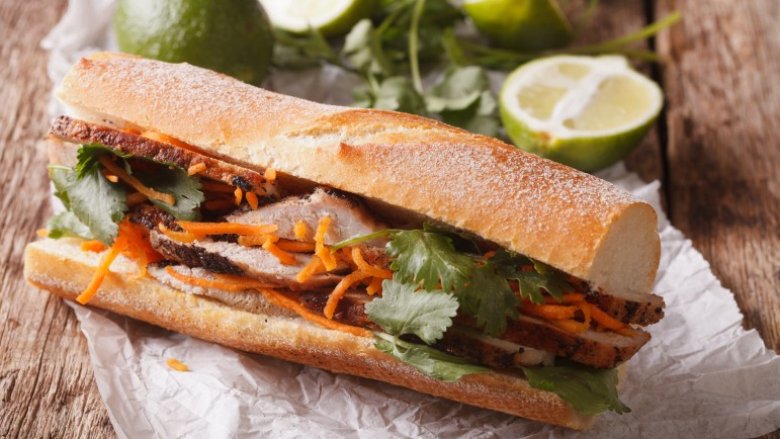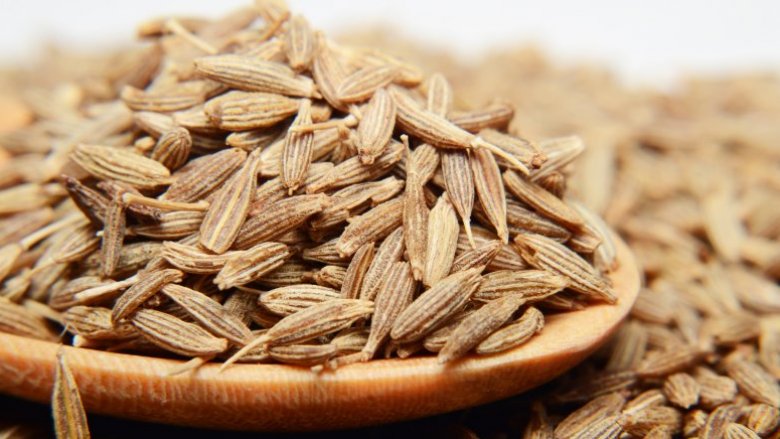Food Names You've Been Saying All Wrong
We may receive a commission on purchases made from links.
There's nothing worse than going out to dinner and getting stumped over how to ask for what you want. You see the words right there in black and white on the menu, but you get tripped up because you aren't sure how to pronounce a particular word. You shore up your courage and instead of pointing at the menu, take a chance — and the server gives you a look that says you've butchered the heck out of the pronunciation. It's OK, we've all been there. Help is on the way. We've got a list of foods that are commonly mispronounced and the key to saying them correctly, so the next time you're ready to enjoy a nice meal (or just talk food) you don't have to resort to pointing. From now on, you can say these names correctly — and pay no mind to the fact that you've been mispronouncing them your entire life.
Sriracha
How do you say it? See-rah-chuh. The first "R" is not pronounced at all. The sauce is thought to have originated in the Thai town of Si Racha, which takes its name from the Sanskrit for "glory to our king". For real authenticity, each syllable should carry a separate emphasis, as shown in this video.
What is it? Sriracha is a Thai hot sauce that has become nearly ubiquitous thanks to its mouthwatering combination of chili pepper and garlic, with notes of sweet, sour, and salty, and a heat level that's just friendly enough to make it truly versatile.
How do you use it? Originally intended as a dipping sauce, Sriracha is now used to spice up all kinds of dishes, from pho to chicken wings, and has been used as a flavoring for everything from peanuts to popcorn. For those with a milder palette, it mixes well with mayonnaise. You can even make your own Sriracha at home.
Acai
How do you say it? Ah-sigh-ee. The way it's spelled might tempt you to pronounce the name of this fruit "ak-cay or "ak-ee", but the "c" is soft. And doesn't that sound a little tastier anyway?
What is it? Acai berries are a fruit harvested from a type of palm tree that grows in Central and South America. The dark berries look like over-sized blueberries and are the current darling of smoothie enthusiasts. Acai has a rich taste you'll often see featured in bottled juice blends and touted for their superfood status. The berries' antioxidants are thought to help fight cholesterol, promote weight loss and much more. It's not easy to find fresh acai berries, but you can easily purchase them in powder form or as a frozen puree.
How do you prepare it? Blend up a smoothie bowl that features acai. The fruit pulp becomes part of the base along with other fruits like pineapple and raspberries. Toppings like shredded coconut, chocolate, granola and yogurt make these smoothies deliciously hearty meals.
Worcestershire
How do you say it? Wus-tah-sheer. Only three syllables.
What is it? A fermented savory sauce of vinegar, anchovies, molasses, tamarind, and spices, which may have its roots in India or Ancient Rome, but became famous when it was produced and bottled in the town of Worcester in the county of Worcestershire in England.
How do you use it? A few dashes of Worcester adds a salty umami depth to soups, stews, chili, or a perfect grilled cheese sandwich. It's also a common ingredient in Caesar salad and Bloody Mary cocktails. You can also use it to make an amazing steak marinade.
Paczki
How do you say it? Pawnch-kee. To most eyes, the spelling offers few clues to the pronunciation, so if you need to remember it, think of these sugary deep-fried treats as the key to getting a paunch!
What is it? Polish filled donuts made with a dense, egg-enriched dough. The filling is usually a fruit jam, but custard and cream versions are also common. Like pancakes, paczki are traditionally enjoyed by many on the last day before Lent, as a way to use up fat and sugar before fasting.
How do you prepare it? The secret ingredient in a perfect paczki is just a little alcohol, which stops the donuts from becoming too oily during frying. Try this recipe for an authentic traditional treat.
Gyros
How do you say it? Yee-ros. Be honest, is that how you were saying it?
What is it? Gyros are a combination of lamb and beef that's ground, seasoned and pressed together. The mixture is then cooked rotisserie style. After cooking, the meat is suspended on a pole so it can be spun while thin slices are shaved from it for sandwiches and meal platters.
How do you prepare it? Make your own gyros. It's not difficult at all.
Beignet
How do you say it? Ben-yay. Say it five times fast and you won't mispronounce it ever again.
What is it? Beignets are fried dough fritters, made from a delicate yeast dough and fried in hot oil until they puff up to become light-as-air doughnuts. When they're ready, they're topped with a heavy dusting of powdered sugar. Beignets are famous in New Orleans, but their history goes back to Ancient Rome. In New Orleans beignets have been an icon of the French Market coffee scene since Cafe du Monde started serving them in 1862.
How do you prepare it? Bring the French Quarter to your kitchen with this recipe for homemade beignets. Serve them with cafe au lait for a completely authentic experience.
Gnocchi
How do you say it? Nyo-ki. Don't pronounce the G! The name likely comes from the Italian for a knot in wood, "nocchio". A single gnocchi is a gnoccho.
What are they? Soft dumplings served with fresh sauces and grated cheese, usually made with riced potatoes, and popular in Italy as an alternative to pasta. Before potatoes came to Europe, gnocchi were most likely made with flour or even breadcrumbs.
How do you prepare them? With patience and determination! The hard part is making the dumplings, which are typically shaped by hand. Cooking them in boiling water takes only a few minutes.
Bouillabaisse
How do you say it? Boo-yah-baze. Don't pronounce the "l's", it will totally give away that you've never spent a year in Provence.
What is it? A fish stew from the Provence region of France, bouillabaisse is set apart from other regional fish soups and stews by the fennel, orange, and saffron that flavors the broth. The Mediterranean dish can include a variety of fish from eel and halibut, to sole and whiting, to shellfish like mussels, crab and lobster.
How do you prepare it? This recipe starts with a homemade fish stock. If you don't have time to make your own, pick some up at the fish market. They'll usually have some frozen fish stock available.
Anise
How do you say it? An-niss. You might hear someone pronounce it as "A-niece", but the "i" is soft. Now you can order up these spices like a pro.
What is it? If you love licorice, you'll like anise (sometimes called aniseed). The tiny seeds come from an herb plant of the same name and are used to flavor both savory and sweet dishes. Anise is the distinct taste in ouzo, the popular greek liqueur and other licorice liqueurs like pernod and sambuca.
How do you prepare it? Anise is well known for its role in classic Italian biscotti and often shows up in sausage.
Pho
How do you say it? Fuh. Don't let that long "o" try to sneak its way into the act. It's got no business there whatsoever.
What is it? Aside from getting the pronunciation right, there's also an art to eating a bowl this Vietnamese noodle soup. Don't overdo the condiments or you'll miss the essence of the special broth that the abundant helping of rice noodles and succulent pieces of meat are swimming in. The bone broth is nuanced heady spices like star anise and cinnamon. The bowl of soup is garnished with a big pile of fresh herbs and vegetables that include green onions, cilantro, basil, slices of fresh hot peppers, bean sprouts, and lime wedges.
How do you prepare it? Make this soup yourself if you aren't close enough to a Vietnamese restaurant that serves pho.
Espresso
How do you say it? Ess-press-o. Tip: If you don't see an "x", don't pronounce one.
What is it? Grind fresh coffee beans super fine and send a quick, high pressured shot of steaming hot water through them and you've got espresso. With all that intensity, it's surprising to learn that espresso isn't made with a special type of coffee bean at all: the water pressure and the size of the grind are what make espresso possible. These miniature cups of intense coffee have a rich, foamy head on top called the crema and actually contain less caffeine than a regular cup of coffee.
How do you prepare it? Become your own barista with this advice and get the most from your home machine. While sipping a shot of espresso is a great midday pick-me-up, that's not all you can do with that dark elixir. Pour a shot over ice cream or stir it into cake batter for deep flavor.
Maraschino
How do you say it? Mare-es-kino. That "sch" makes a "k" sound. Who knew?
What is it? Who didn't clamor for the cherry in their parent's dessert when they were a kid? That bright red fruit beckoned so enticingly. While they may start out innocently enough when they are picked from the tree, maraschino cherries undergo a scary process of bleaching, dying and curing in high fructose corn syrup to achieve their look.
How do you prepare it? Want to go all natural? Give homemade brandied cherries a try.
Poke
How do you say it? Po-kay. From the Hawaiian word meaning "chunk". The word is pronounced as if there were an acute accent over the e, like Pokémon, and is sometimes written that way on menus, though that's technically incorrect. Poke has no relationship to Pokémon.
What is it? A Hawaiian dish of seasoned and marinated raw fish, similar to Japanese sashimi, usually made with ahi tuna, though octopus is also a common ingredient. Poke has grown in popularity as a protein-rich alternative to a salad, often served on a bed of grains or greens.
How do you prepare it? You can make your own poke by dicing fresh or sashimi-grade fish and tossing it with soy sauce, sesame oil, and seasonings such as onion, seaweed, chili flakes, furikake, roasted sesame, etc.
Raita
How do you say it? Rye-ta. This one's easy. Surely you'll get it right-a.
What is it? This creamy condiment combines yogurt, cucumber and cumin and is a mainstay in Indian cuisine. It plays the role of a cooling palate cleanser that's eaten between tastes of other boldly-flavored or spicy dishes.
How do you prepare it? Raita is easy to make. Try this one from Saveur. As the recipe headnote suggests, you might find more ways to use it in addition to serving it with Indian cuisine.
Turmeric
How do you say it? Tur-mer-ick. Don't feel bad if you've been saying "too-mer-rick." Apparently chefs do it too.
What is it? Fresh yellow turmeric looks a lot like a dark version of ginger on the outside. Inside however, its deep orange color is revealed. That color is termeric's signature. The spice is enjoying a moment in the spotlight due to the potential antioxidant benefits that curcumin, a compound found in turmeric, is being attributed with. Researchers are studying turmeric and curcumin's effect on heart disease, cancer, Alzheimers and more.
How do you prepare it? Want to get more turmeric into your diet? Check out this collection of recipes.
Coq au vin
How do you say it? Coke-ah-van. This is important: vin means wine in French. If nothing else, you'll want to know how to pronounce that.
What is it? If you've got an old tough chicken (coq means rooster) that needs to get cooked, this dish is the ticket. It will turn what might otherwise be a meal failure into a dinner of fall-of-the-bone tender chicken and vegetables infused with the flavors of its wine braising liquid. You can, of course, make this one-pot dish using a chicken that didn't rule the roost well into its old age (i.e. one from the grocery store). The results will be just as delicious. This French dish, which literally means rooster with wine, is prepared with mushrooms, bacon, onions and carrots. The wine is reduced for a rich sauce that glazes the chicken once it's ready.
How do you prepare it? David Leite offers some tips for making Julia Child's famous rendition of this classic dish.
Rooibos
How do you say it? Roy-boss. Don't be fooled into saying "roo-ee-boes". The word is sometimes spelled "rooibosch", but it's still pronounced "boss", not "bosh"!
What is it? A herbal tea made from a South African plant. The name means "red bush" in Afrikaans, and though the plant isn't especially red, the dried oxidized leaves are a reddish-brown color.
How do you prepare it? The dried leaves are used exactly like tea leaves; brewed in freshly boiled water, with milk, sugar, or substitutes added according to taste. Rooibos is naturally caffeine-free, making it a popular alternative to tea for anyone trying to avoid or cut back on caffeine.
Jicama
How do you say it? He-ka-ma. The name is Spanish, so non-Spanish speakers may want to think of that J as an H.
What is it? The starchy edible root of a Mexican vine, sometimes called the Mexican potato or the Mexican yam. It's similarly versatile, with a sweet, nutty flavor, and it's popular in both Latin American and Asian cuisines.
How do you prepare it? Jicama can be used for just about anything you'd use potatoes for, including chips and fries, but it has one significant advantage over potatoes; you can eat it raw. That means it's great in a salad, salsa, or slaw, where it provides an excellent crunch.
Foie Gras
How do you say it? Fwa gra. French for "fat liver". Drop the "S", and rhyme the syllables!
What is it? It's a fat liver; the liver of a goose or duck, fattened up to make it especially buttery. The animal's liver is enlarged to up to ten times its normal size by force-feeding, which many consumers condemn as a form of animal abuse, though there's some debate as to whether the animals actually suffer. Some attempts have been made to produce foie gras without force feeding, but it's hard to come by — and very expensive.
How do you use it? Foie gras can be turned into a pate, mousse, or terrine, or poached or pan-seared and served whole.
Dulce de leche
How do you say it? Dul-say de leh-chay. The word uses the American Spanish pronunciation of "dulce", with a soft "S", rather than the European Spanish "ch" sound, as it's believed to originate in Argentina, not in Spain.
What is it? A type of sweet, sticky spread made by slowly heating condensed milk in order to caramelize the sugars. The name literally means "milk sweet".
How do you prepare it? The easiest way is to simmer a can of condensed milk in a pan of water. The resulting delicious brown gloop can be used in cakes and cookies, or as a sweet treat on its own. Be careful not to open the can until it has cooled; there's serious danger of burning yourself.
Parmesan
How do you say it? Par-mi-zahn. But this is controversial; "Parmesan" is the French name for an Italian cheese, so it should carry the French pronunciation. The strong presence of Italian immigrants in North America may explain why it's often pronounced "Par-mi-jahn", echoing the correct pronunciation of the Italian name, "Parmigiano", even when the French spelling is used.
What is it? Hard Italian cheese with a crystalline structure and a strong salty flavor, made from grass- and hay-fed cows' milk that's collected at night and skimmed in the morning. The finished cheeses are brined for about three weeks and cured for a year.
How do you use it? Grated over pasta, curled into a salad, or stirred into a creamy risotto. The explosive little crystals that form in mature Parmesan also make it a really great cheese for snacking on.
Bruschetta
How do you say it? Brew-sket-ta. Many will say "brew-shet-ta" and no one is going to penalize them for it. If you're roaming around Tuscany where this antipasti is often served and you want to fit in with the locals, you might do well to know that in this case, the "ch' is pronounced as a "k" sound.
What is it? Bruschetta are small toasted breads. At their most basic level, it's simply bread rubbed with garlic that's also brushed with olive oil and then cooked over coals or in the oven until lightly charred. Bruschetta can be served plain but are often served with toppings like chopped tomatoes and basil or sauteed mushrooms.
How do you prepare it? Make these porcini topped bruschetta or keep basics with these tomato toast.
Caipirinha
How do you say it? Ky-pa-reen-ya. If you're inhibited, a few caipirinha will help loosen your tongue and eliminate any shyness too.
What is it? If you're visiting Brazil, a caprihina is the cocktail you're practically required to drink. It's made with the country's national liquor, cachaça, limes, sugar and ice. Muddling whole cut up limes for the drink, releases the juices and essential oils and brings a very forward citrus flavor. Watch out though: cachaça is the epitome of "the hard stuff" and these tasty, bright, limey cocktails pack an unexpectedly potent punch.
Banh mi
How do you say it? Bun-me. Avoid saying "Ban-my" if you order one. No telling what you'll get if you do.
What is it? Banh mi is a Vietnamese sandwich that combines both Vietnamese and French food traditions. A baguette (from France) is the inspiration for the soft-on-the inside, crusty-on-the-outside loaf the sandwich is built on. Pate, also from the French, is one traditional meat filling for the sandwich, but almost any roasted meat can be used. What defines the sandwich and comes from Vietnamese food traditions is the vegetables. Pickled carrots, daikon radishes, cucumbers and cilantro are piled on top of the meat and bring distinct tangy-sweet flavor. A swipe of creamy mayonnaise adds richness and slices of jalapeno give the sandwich spicy heat.
How do you prepare it? If you don't have the chance to hop on a plane a grab one of these for real, follow The Banh Mi Handbook author, Andrea Nguyen's master recipe.
Cumin
How do you say it? Koo-min and kyoo-min are both correct, in American and British English, respectively, but the other popular pronunciation, kum-in, may have the oldest pedigree, even if it's fallen out of favor. This may be one food word that everyone pronounces differently, but no-one pronounces wrong!
What is it? The aromatic seeds of a plant that grows in many parts of the world. As a spice, it's especially popular in Indian and South American cooking, where the distinctly pungent, earthy flavor is a mainstay in dishes from curry to chili.
How do you prepare it? The best way to use cumin in cooking is to buy whole seeds, and either toast them in a dry pan or fry them in oil to release their full aroma and complexity.


